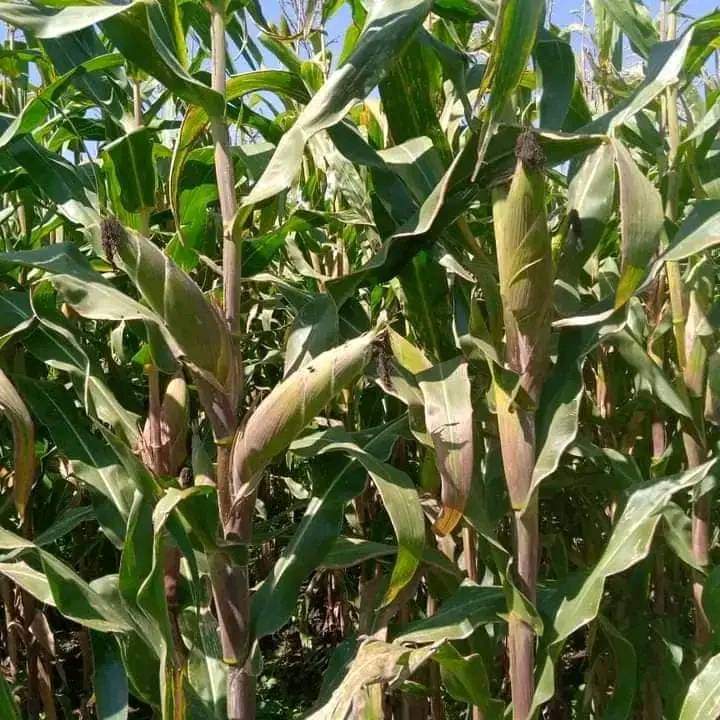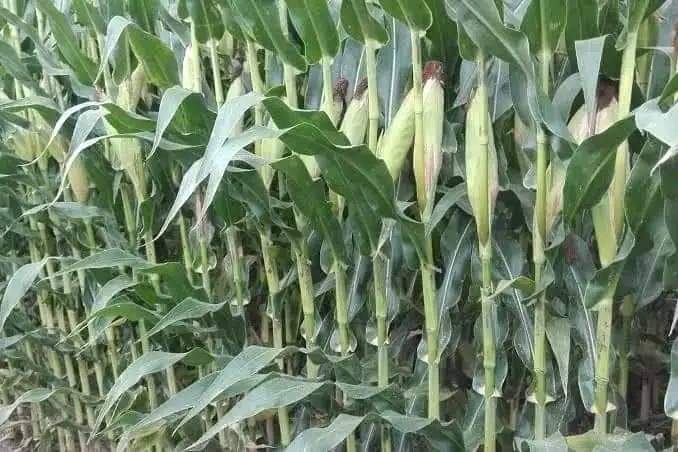Maize farming holds paramount significance within Kenya’s agricultural landscape, making substantial contributions to both food security and the national economy.
Delving into the intricacies of maize cultivation in Kenya unveils a comprehensive spectrum of practices, ranging from varietal selection and planting methods to nutrient management, pest mitigation, irrigation strategies, harvesting techniques, and marketing endeavors.
In Kenya, maize farming stands as a cornerstone of agricultural activities, pivotal in sustaining food security and bolstering the country’s economic framework.
Exploring the multifaceted dimensions of maize cultivation within this context reveals a mosaic of practices encompassing varietal diversity, planting methodologies, nutrient optimization, pest management, irrigation techniques, harvesting methodologies, and marketing strategies.
Maize Climate Requirements
Maize thrives as a warm-season crop, necessitating temperatures of 10-15°C for optimal germination and growth.
In Kenya, prime conditions for maize cultivation are found in regions situated between 900 to 2,500 meters above sea level.
These areas benefit from a mean annual rainfall ranging from 600 to 1,200 mm, evenly spread across the growing season. Nonetheless, maize farming can also flourish in drier locales with the aid of irrigation.
Maize Soil Requirements
Maize exhibits adaptability to diverse soil types, yet thrives optimally in well-drained, nutrient-rich soils with a pH range of 5.5 to 7.5.
Adequate organic matter content in the soil enhances fertility and moisture retention, crucial for robust crop development. In regions experiencing high rainfall, ensuring proper soil drainage is imperative to prevent waterlogging, which can hinder maize growth and yield.
Conducting soil tests is advisable to assess nutrient levels and tailor fertilizer application for optimal maize cultivation.
Maize Varieties Grown in Kenya
In Kenya, a nation marked by diverse ecological zones, maize farming boasts a rich array of varieties tailored to specific conditions:
Hybrid Maize:
These hybrids result from crosses between different maize plants, engineered to exhibit traits like heightened yields, enhanced resilience against pests and diseases, and improved drought tolerance. Notable examples in Kenya include H624, H614, and H512.
Open-Pollinated Varieties (OPVs):
Untouched by genetic modifications, OPVs rely on natural pollination mechanisms such as wind and insects. Adapted to a wide spectrum of environmental conditions, they have been cultivated in Kenya for generations. Common OPVs in Kenya encompass Katumani, MH18, and PH4.
High-Altitude Maize:
Tailored for cooler temperatures and elevated terrains, high-altitude maize varieties boast extended maturation periods but offer superior yields. Among the favored selections in Kenya are Longe 5, H614, and H621.
Quality Protein Maize (QPM):
A unique maize type prized for its elevated protein content and superior amino acid profile, QPM varieties play a crucial role in combating malnutrition and enhancing the dietary quality of vulnerable populations. Noteworthy QPM cultivars in Kenya encompass Mwaiwathu, Makueni, and KDV4.
Farmers in Kenya make judicious selections of maize varieties, taking into account factors like soil type, climatic conditions, market demand, and agricultural practices. Government agencies and agricultural research institutions provide invaluable guidance, aiding farmers in optimizing their maize cultivation for maximal yields and profitability.
Land Preparation
Land preparation stands as a pivotal phase in maize farming within Kenya, with meticulous attention contributing to heightened yields and superior crop quality.

Clearing the Land:
Prior to maize sowing, thorough clearance of the land from bushes, trees, and grass is imperative. This task is executed through either manual labor or mechanized approaches. Manual land preparation entails the use of implements like hoes, machetes, or slashers, while mechanical methods employ tractors or ploughs to clear the terrain.
Tillage:
Subsequent to land clearance, soil tillage is requisite to fashion a suitable seedbed for maize cultivation. This process entails loosening the soil and disintegrating any clods to establish a uniform surface. Implements such as disc harrows, chisel ploughs, or cultivators are deployed for this purpose.
Soil Fertility Augmentation:
Optimal maize growth hinges upon fertile soil. Therefore, soil testing to ascertain its nutrient profile is essential prior to planting. In cases of nutrient deficiencies, including nitrogen, phosphorus, and potassium, fertilizers are administered to enrich soil fertility. Organic fertilizers like manure and compost are favored for their ecological sustainability and cost-effectiveness.
Soil pH Adjustment:
Maize thrives in soils with a pH range of 6.0 to 7.5. Should the soil exhibit pH deviations, corrective measures involving the application of lime or sulfur are implemented to align it within the optimal range for maize cultivation.
Ridge and Furrow System:
In regions characterized by high rainfall or poorly drained soils, adoption of a ridge and furrow system aids in enhancing soil drainage and mitigating waterlogging. This technique entails planting maize atop raised ridges, with furrows interspersed between. The ridges furnish an ideal planting bed, while furrows facilitate efficient water drainage.
Planting Techniques for Maize Farming in Kenya:
Planting constitutes a pivotal juncture in maize farming, dictating crop yield and quality. Kenyan farmers employ the following techniques:
Time of Planting:
Maize is typically sown during the rainy season in Kenya, with the onset of rains marking the opportune period for planting. In certain locales, farmers engage in multiple plantings annually to capitalize on available rainfall.
Spacing:
Optimal plant spacing is critical for maximizing maize yield. The recommended spacing in Kenya is 75cm between rows and 30cm between plants, though adjustments may be made based on factors such as variety, soil fertility, and precipitation levels.
Depth of Planting:
Maize seeds should be sown at a depth of 5-10cm. Shallow planting may impede germination, while excessive depth can lead to delayed emergence and stunted growth.
Seed Rate:
The prescribed seed rate for maize in Kenya ranges from 20-25 kg per acre, contingent on factors like variety, spacing, and soil fertility.
Planting Methods:
Various planting methods are employed in Kenyan maize farming, encompassing drilling, broadcasting, and dibbling. Drilling involves creating furrows in the soil, depositing seeds, and covering them with soil. Broadcasting entails spreading seeds across the soil surface and incorporating them into the soil. Dibbling involves creating small holes in the soil, inserting seeds, and covering them with soil.
Pre-Planting Treatment:
Some Kenyan farmers subject maize seeds to pre-planting treatments to mitigate pest and disease infestations, enhance germination rates, and promote robust plant growth. Treatment modalities include seed soaking, application of fungicides or insecticides, and utilization of biofertilizers.
Through adherence to appropriate planting techniques, Kenyan farmers can optimize maize growth and yield, thereby augmenting income levels and bolstering food security.
Maize Fertilizers
Maize farming in Kenya demands meticulous fertilizer management to optimize yields, with both basal and foliar fertilizers playing integral roles in the cultivation process.
Basal Fertilizer Application:
At planting time, it’s advisable to incorporate a teaspoonful of Diammonium Phosphate (DAP) fertilizer into each planting hole, ensuring thorough mixing with the soil before seed placement. Alternatively, mechanized planters equipped with fertilizer hoppers can be employed for precise application. Another method involves pre-mixing DAP with soil at a rate of 50kg per acre. DAP, rich in phosphorus, fosters robust root development. It’s crucial to achieve even distribution to prevent seed burn.
Foliar Fertilizer Application During Early Stages:
Foliar fertilizers are administered directly onto maize leaves.
Top Dressing Fertilizer Application:
Following emergence, top dressing with Calcium Ammonium Nitrate (CAN) fertilizer is recommended around 2-3 weeks post-planting or when the crop reaches a height of 45cm or 1.5ft. Apply one teaspoonful of CAN fertilizer at the base of each plant in a ring formation or along the row, maintaining a distance of approximately 15cm from the plant.
In regions with ample rainfall, top dressing is bifurcated into two stages, with the initial application conducted 6 weeks post-sowing and the subsequent one 10-15 days later, or just before tasseling. Conversely, in areas with scant rainfall, a single application suffices, typically ranging from 50-100kg per acre.
CAN facilitates nitrogen fixation in the soil, pivotal for leaf vitality and photosynthesis. Alternatively, other nitrogenous fertilizers like urea can be employed.
Maize Pest and Diseases in Kenya
Maize farming in Kenya confronts numerous pest and disease challenges that, if left unchecked, can lead to substantial crop losses. Here are some prevalent issues and their management strategies:
Pests:
- Fall Armyworm: This voracious pest attacks maize throughout various growth stages, posing a severe threat. Farmers can combat it using insecticides like OCCASION STAR® 200SC or ESCORT® 19EC, ideally applied in the evening or early morning for optimal efficacy.
- Stalk Borer: These larvae bore into maize stalks and cobs, weakening the plant and causing significant losses. Insecticides such as PROFILE® 440EC can be employed for control.
- Maize Aphids: These sap-sucking insects distort leaves and stunt plant growth while also spreading viral diseases. KINGCODE ELITE® 50EC is an effective insecticide for aphid management.
- Cutworms: These soil-dwelling pests target young plant stems. Control measures involve soil drenching with insecticides like PROFILE® 440EC.
Diseases:
- Maize Lethal Necrosis Disease (MLND): A viral disease manifesting as chlorotic mottling on leaves, MLND can be mitigated by controlling vectors like aphids and ensuring proper plant nutrition.
- Maize Smut: This soil-borne disease affects tassels and kernels, leading to severe crop losses. Fungicides such as PYRAMID® 700WP or GREEN COP® 500WP can be used for soil drenching.
- Northern Leaf Blight: Identified by gray-green lesions on leaves, this fungal disease can be managed using fungicides like GEARLOCK TURBO® 250WP.
To minimize pest and disease impact, farmers are advised to opt for certified seeds, utilize resistant varieties, and adopt crop rotation practices. These proactive measures contribute to sustainable maize farming in Kenya.
Maize Production Per Acre in Kenya
The concern for every farmer prior to planting revolves around the eventual harvest. Estimating the yield for maize is straightforward, typically measured in bags per acre. Under optimal conditions, where the best farming practices are implemented, one can anticipate harvesting approximately 40 bags of maize per acre. However, many farmers fall short of achieving this potential yield. Factors such as limited farm inputs often lead to reduced productivity, with an expected yield dropping to around ten bags per acre. This significant reduction of 30 bags highlights the crucial impact of farming practices employed during planting. Hence, it’s imperative for farmers to exercise caution and diligence. On average, maize farmers can anticipate producing anywhere between 10 to 25 bags per acre of farmland.
Maize Seed Varieties in Kenya
Pannar 691 Maize Variety:
Considered by many as the benchmark for yield since its release in 2001. Typically requires 160 days to maturity in most highland areas. Exhibits good disease resistance and, based on fungicide trials, shows relatively low response to fungicides.
Pannar 683 Maize Variety:
Although not as widely embraced as 691, 683 is essentially a clone of the former. It offers no improvement in yield and shares similar traits in standing power and disease resistance. Consequently, there’s little incentive for growers to opt for 683 over 691.
Pioneer Maize Seed 30G19:
This variety boasts strong yield potential, comparable to 691, but is noted for its average standing power. Lodging is a notable weakness despite producing brilliant white grain. It matures approximately 10 days earlier than 691 and is known for its consistency.
P3812 Maize Variety:
Characterized by large, stubby cobs with over 14 or 16 grains each. While rust susceptibility requires monitoring, it remains stiff and high yielding, often outperforming 691 particularly at lower populations. Cobs tend to sit lower on the plant but exhibit reasonable drooping.
SC Twiga 81 Maize Variety:
This variety shows promise with its high yield potential, but its susceptibility to rust, especially for its tall stature, is a drawback. It’s considered a versatile variety but may pose challenges during mechanical harvesting due to the height of its cobs.
FreshCo 600-16A:
While it stands well, FreshCo 600-16A falls short of the yield offered by Kenya Seed maize varieties. It may exhibit slightly better resistance to rust and leaf blight compared to others.
Hybrid Seed Maize H6213:
Despite being prone to rust, H6213 demonstrates reasonable standing power for its tall structure and frequently produces double cobs. However, effectively spraying for fall armyworm can be challenging due to the height of the cobs.
Hybrid Seed Maize H6218:
Offering a slight yield advantage over H6213, H6218 also shows potential for reduced susceptibility to Northern Corn Leaf Blight. It’s favored by livestock farmers for forage but may not be ideal as a commercial grain maize variety.
Hybrid Seed Maize H614D:
An older variety, H614D exhibits lower yields compared to more recent introductions. It may suffer from lodging, especially under adverse weather conditions, and shows poor resistance to grey leaf spot.
DK 90-89 Maize Variety:
Renowned for its standing power, DK 90-89 is worth trialing at different seed densities to compare its performance with other varieties. It matures slightly earlier than 691 and offers superior grain quality with fewer discolored and rotten grains.
PAN 15:
A stiff and short variety suitable for higher plant populations. Its shorter stature allows for later sprays against fall armyworm and leaf blight. However, it may require careful monitoring for late-stage collapse.
Pan 8M-93 Maize Variety:
While it may stand well initially, Pan 8M-93 can collapse late in the season. It matures slightly earlier than 691 and its tolerance to Group B herbicides offers potential benefits for weed management, pending regulatory approval in Kenya.
3 Months Maize Seeds
Medium Altitude Varieties: Maize varieties suited for medium altitude areas are likely to perform well even in high altitude regions during the short rains due to their shorter maturity period. Farmers experiencing poor maize growth can utilize the short rains to replant using the following varieties:
- Kenya Seed Company: H513, H515, H516, H517, H518, H519, H520, H521, and H522.
- Western Seed Company: WH507, WH505, WH403, WH403, and WH402.
- FRESHCO: KH500-33A and KH500-13A.
Dryland Varieties: Given the unpredictable weather patterns, it’s essential for farmers not to solely rely on medium altitude varieties. Dryland varieties are also recommended. The following dryland varieties are available in the market:
- KARI: Katumani composite (open-pollinated).
- Kenya Seed Company: DH01, DH02, DH03, and DH04.
- FRESHCO: KDV1 and KDV.
Challenges Facing Maize farming in Kenya
Maize farming in Kenya encounters various challenges alongside promising opportunities that could enhance productivity and profitability:
Challenges:
- Climate Change and Variability: Unpredictable weather patterns like erratic rainfall and prolonged droughts hamper crop yields. Adopting climate-smart practices such as crop diversification and water harvesting could mitigate these effects.
- Poor Seed Quality: Reliance on uncertified or recycled seeds leads to low yields and susceptibility to pests and diseases. Promoting access to certified seeds and supporting smallholder seed production could improve maize quality and quantity.
- Pests and Diseases: Maize is vulnerable to pests like stem borers and diseases such as maize lethal necrosis. Integrated management strategies including resistant varieties and cultural practices are crucial for pest and disease control.
- Inadequate Storage and Post-Harvest Handling: Insufficient facilities and practices contribute to high post-harvest losses and reduced grain quality. Enhancing storage facilities and implementing proper handling techniques like drying and cleaning could mitigate losses.
- Limited Access to Credit and Markets: Farmers struggle to access credit and markets, hindering investment in inputs and technology. Government interventions such as credit facilities and market linkages could boost productivity and profitability.
Opportunities:
- Value Addition: Maize sector presents opportunities for value addition including flour production, animal feed, and biofuels, fostering employment and industrialization.
- Technology Adoption: Modern technologies like precision farming and digital agriculture offer avenues for enhancing productivity and mitigating climate change effects.
- Regional and International Markets: Kenya’s maize production potential positions it as a key player in regional and international markets. Improved infrastructure, market access, and trade policies could bolster maize exports.
In summary, while maize farming in Kenya faces several challenges, leveraging opportunities like value addition, technology adoption, and market access could drive transformative growth, contributing to the country’s economic development.

